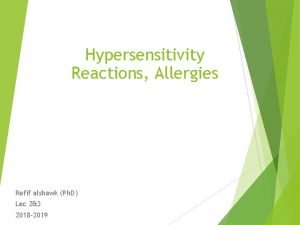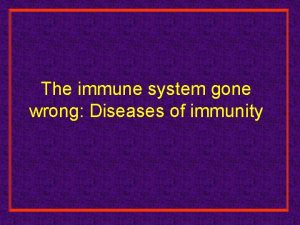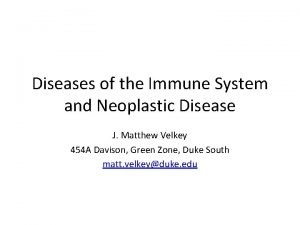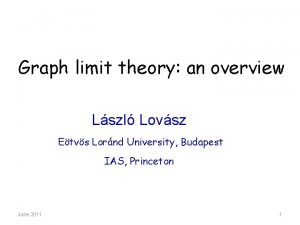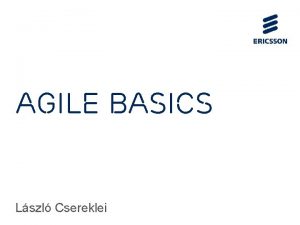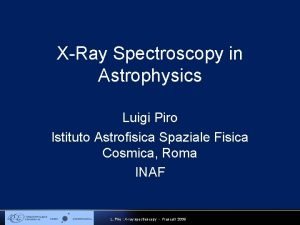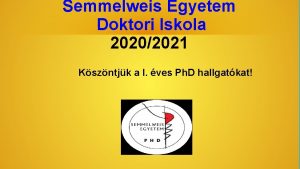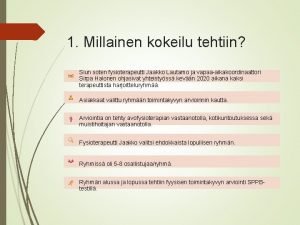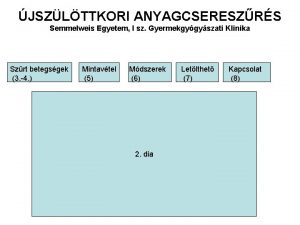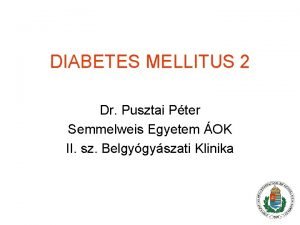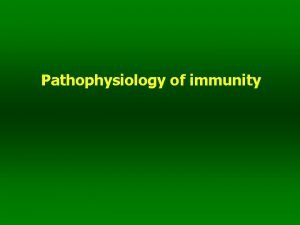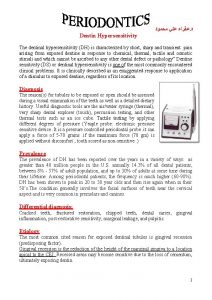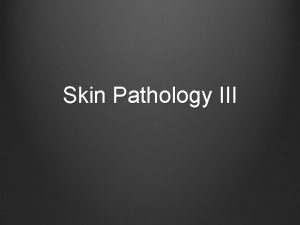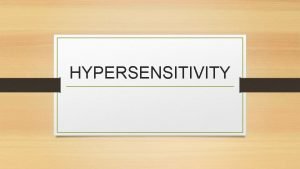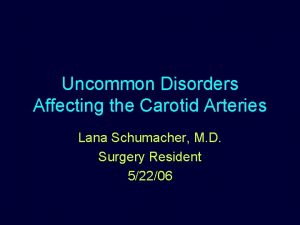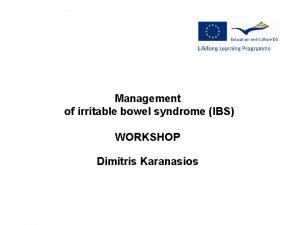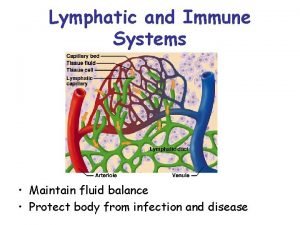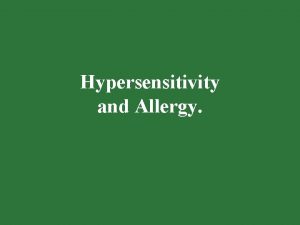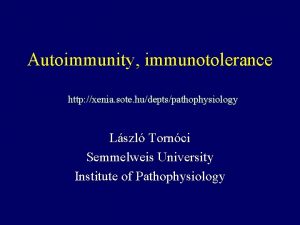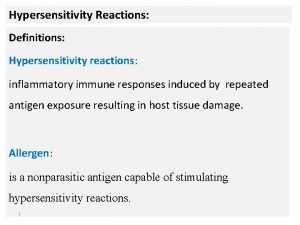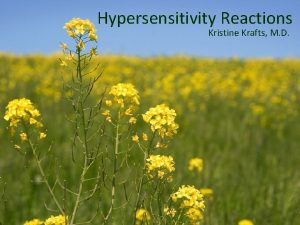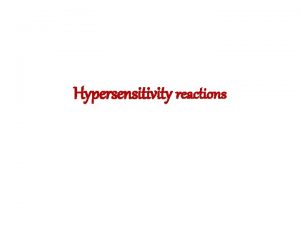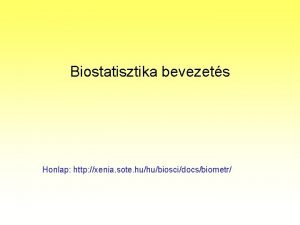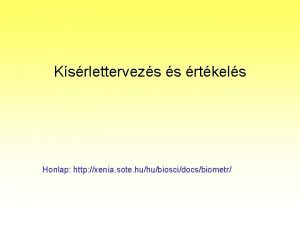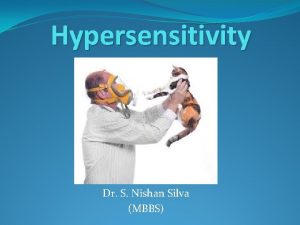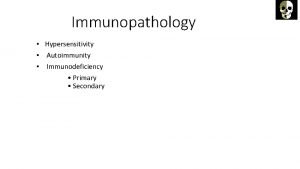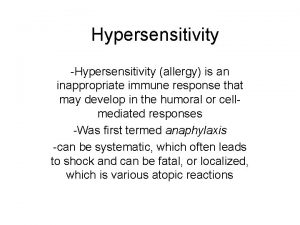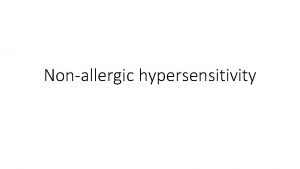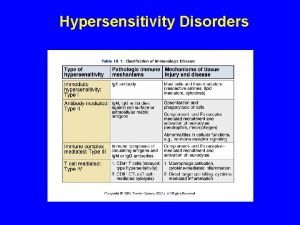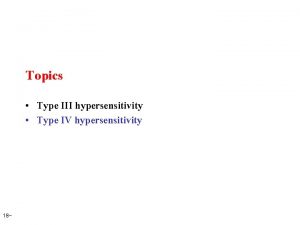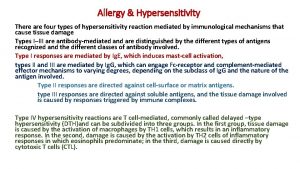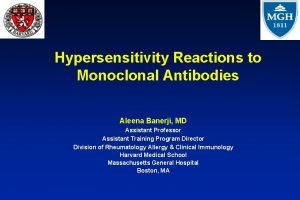Hypersensitivity reactions http xenia sote hudeptspathophysiology Lszl L








































- Slides: 40

Hypersensitivity reactions http: //xenia. sote. hu/depts/pathophysiology László L. Tornóci Semmelweis University Institute of Pathophysiology

Classification

Type 1 hypersensitivity reaction Hypersensitivity of immediate type

Terminology • Hypersensitivity of immediate type fastest reaction of all four • Allergy rare, tissue damage • Anaphylaxy generalized, severe reaction • Atopy an umbrella term for genetic susceptibility

Clinical significance • Very common, increasing trend – 30 -40% of the population in developed countries – gets more and more common since 1800 – very great (10 -15 -times) geographical difference • The anaphylactic reaction is rare, but sever (may cause death)

Diseases • • • urticaria allergic rhinitis atopic eczema asthma food allergy anaphylaxy

Bee sting

Food allergy

Common allergens Airways: • pollen (grass, tree, flower) • household dust (mite: Dermatophagoides pteronyssinus) • animal hair (cat, dog) Enteral/parenteral (anaphylactic reaction): • drug (e. g. penicillin) • food (milk, fish, shellfish, peanut) • sting (bee, wasp)

Dermatophagoides mite

Type 1: pathomechanism

Activation of mast cells

Activation of Th 1 and Th 2 cells

Factors involved in Th 1/Th 2 activation

Heredity A few genes causing atopy • • MHC class II Fc RI ( subunit) IL-4 cytokine cluster IL-4 receptor ( subunit)

Diagnostics, total Ig. E

Diagnostics, skin prick test

The advantage of type 1 reaction

Type 2 hypersensitivity reaction Antibody-mediated cytotoxicity

Diseases • • Incompatible blood transfusion Autoimmune hemolytic anamia (AIHA) Goodpasture syndrome Pemphigus vulgaris (Ag: desmoglein)

Mechanisms • • complement activation MAC cytolysis complement activation, chemotaxis ADCC reaction „frustrated phagocytosis”

“Frustrated phagocytosis”

Symptoms of the transfusion reaction • • • fever BP drop lumbar pain chest pain nausea, vomiting

Maternal-fetal Rh incompatibility

Erythroblastosis fetalis

Autoimmune hemolysis The “innocent bystander” mechanism

Diagnostics: indirect Coombs’ test

Type 2 reaction without tissue damage Blocking antibodies

Type 3 hypersensitivity reaction Immune complex reaction

Circulating immune complexes Antigen Place of deposition microbial Ag site of infection, kidneys autoimmunity autoantigen kidneys, joints, vessels, skin external environmental Ag lungs Cause chronic infection

Diseases • • classic serum sickness-like reaction caused by drugs immune complex reaction caused by infections systemic autoimmune diseases

The time course of serum sickness

Occurrance of immune complexes

Pathomechanism

Type 4 hypersensitivity reaction Delayed type hypersensitivity reaction

Types of delayed hypersensitivity reaction Type of reaction Time of maximal reaction Jones-Mote 1 day contact 2 -3 days tuberculin 2 -3 days granulomatous at least 2 weeks

Contact allergy

Contact eczema

Tuberculin test

Leprosy
 Hypersensitivity reactions
Hypersensitivity reactions Hygiene hypothesis
Hygiene hypothesis Delayed type hypersensitivity reactions
Delayed type hypersensitivity reactions Lszl charts
Lszl charts Lszl charts
Lszl charts Redox reactions half reactions
Redox reactions half reactions Section 2 reinforcement classifying chemical reactions
Section 2 reinforcement classifying chemical reactions Types of reactions
Types of reactions Section 2 classifying chemical reactions worksheet answers
Section 2 classifying chemical reactions worksheet answers Unit 5 chemical reactions answers
Unit 5 chemical reactions answers Sniffing
Sniffing Tgi ventilacion mecanica
Tgi ventilacion mecanica Xenia board of education
Xenia board of education Odyssey book 9 discussion questions
Odyssey book 9 discussion questions Xenia programming languages
Xenia programming languages Xenia labs
Xenia labs Crema años dorados informacion nutricional
Crema años dorados informacion nutricional Odysseus homecoming
Odysseus homecoming Language
Language Xenia resolution scaling
Xenia resolution scaling Hanna nyfors
Hanna nyfors Tietovirtakaavio
Tietovirtakaavio Ilkka pirskanen siun sote
Ilkka pirskanen siun sote Heli sivonen
Heli sivonen Kainuun sote liikuntaneuvonta
Kainuun sote liikuntaneuvonta Sote uudistus
Sote uudistus Kainuun sote palkkatoimisto
Kainuun sote palkkatoimisto Semmelweis neptun
Semmelweis neptun Siun sote ajanvaraus
Siun sote ajanvaraus Sote turvakortti
Sote turvakortti Sote 1 gyermekklinika
Sote 1 gyermekklinika Dr pusztai péter
Dr pusztai péter Dermatomyositis hypersensitivity type
Dermatomyositis hypersensitivity type Dental hypersensitivity
Dental hypersensitivity Fishnet pattern in pemphigus vulgaris
Fishnet pattern in pemphigus vulgaris Schultz-dale phenomenon is which type of hypersensitivity
Schultz-dale phenomenon is which type of hypersensitivity Carotid sinus hypersensitivity
Carotid sinus hypersensitivity Visceral hypersensitivity
Visceral hypersensitivity Type 2 hypersensitivity
Type 2 hypersensitivity Hypersensitivity personality
Hypersensitivity personality Hypersensitivity
Hypersensitivity
